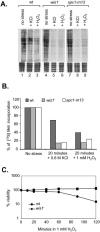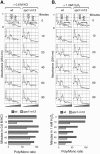Stress-activated protein kinase pathway functions to support protein synthesis and translational adaptation in response to environmental stress in fission yeast
- PMID: 16278445
- PMCID: PMC1287851
- DOI: 10.1128/EC.4.11.1785-1793.2005
Stress-activated protein kinase pathway functions to support protein synthesis and translational adaptation in response to environmental stress in fission yeast
Abstract
The stress-activated protein kinase (SAPK) pathway plays a central role in coordinating gene expression in response to diverse environmental stress stimuli. We examined the role of this pathway in the translational response to stress in Schizosaccharomyces pombe. Exposing wild-type cells to osmotic stress (KCl) resulted in a rapid but transient reduction in protein synthesis. Protein synthesis was further reduced in mutants disrupting the SAPK pathway, including the mitogen-activated protein kinase Wis1 or the mitogen-activated protein kinase Spc1/Sty1, suggesting a role for these stress response factors in this translational control. Further polysome analyses revealed a role for Spc1 in supporting translation initiation during osmotic stress, and additionally in facilitating translational adaptation. Exposure to oxidative stress (H2O2) resulted in a striking reduction in translation initiation in wild-type cells, which was further reduced in spc1- cells. Reduced translation initiation correlated with phosphorylation of the alpha subunit of eukaryotic initiation factor 2 (eIF2alpha) in wild-type cells. Disruption of Wis1 or Spc1 kinase or the downstream bZip transcription factors Atf1 and Pap1 resulted in a marked increase in eIF2alpha phosphorylation which was dependent on the eIF2alpha kinases Hri2 and Gcn2. These findings suggest a role for the SAPK pathway in supporting translation initiation and facilitating adaptation to environmental stress in part through reducing eIF2alpha phosphorylation in fission yeast.
Figures





Similar articles
-
Role of mitogen-activated protein kinase Sty1 in regulation of eukaryotic initiation factor 2alpha kinases in response to environmental stress in Schizosaccharomyces pombe.Eukaryot Cell. 2010 Jan;9(1):194-207. doi: 10.1128/EC.00185-09. Epub 2009 Oct 30. Eukaryot Cell. 2010. PMID: 19880757 Free PMC article.
-
New roles of the fission yeast eIF2α kinases Hri1 and Gcn2 in response to nutritional stress.J Cell Sci. 2013 Jul 15;126(Pt 14):3010-20. doi: 10.1242/jcs.118067. Epub 2013 May 17. J Cell Sci. 2013. PMID: 23687372
-
Fission yeast mitogen-activated protein kinase Sty1 interacts with translation factors.Eukaryot Cell. 2008 Feb;7(2):328-38. doi: 10.1128/EC.00358-07. Epub 2007 Dec 7. Eukaryot Cell. 2008. PMID: 18065650 Free PMC article.
-
Phospho-mimicking Atf1 mutants bypass the transcription activating function of the MAP kinase Sty1 of fission yeast.Curr Genet. 2018 Feb;64(1):97-102. doi: 10.1007/s00294-017-0730-7. Epub 2017 Aug 10. Curr Genet. 2018. PMID: 28799013 Review.
-
Oxidative stress response pathways: Fission yeast as archetype.Crit Rev Microbiol. 2015;41(4):520-35. doi: 10.3109/1040841X.2013.870968. Crit Rev Microbiol. 2015. PMID: 24576188 Review.
Cited by
-
A stress-activated, p38 mitogen-activated protein kinase-ATF/CREB pathway regulates posttranscriptional, sequence-dependent decay of target RNAs.Mol Cell Biol. 2013 Aug;33(15):3026-35. doi: 10.1128/MCB.00349-13. Epub 2013 Jun 3. Mol Cell Biol. 2013. PMID: 23732911 Free PMC article.
-
The activities of the Yersinia protein kinase A (YpkA) and outer protein J (YopJ) virulence factors converge on an eIF2alpha kinase.J Biol Chem. 2009 Sep 11;284(37):24744-53. doi: 10.1074/jbc.M109.010140. Epub 2009 Jun 24. J Biol Chem. 2009. PMID: 19553678 Free PMC article.
-
Proteomic analysis of early-responsive redox-sensitive proteins in Arabidopsis.J Proteome Res. 2012 Jan 1;11(1):412-24. doi: 10.1021/pr200918f. Epub 2011 Nov 21. J Proteome Res. 2012. PMID: 22050424 Free PMC article.
-
Regulation of transcriptome, translation, and proteome in response to environmental stress in fission yeast.Genome Biol. 2012 Apr 18;13(4):R25. doi: 10.1186/gb-2012-13-4-r25. Genome Biol. 2012. PMID: 22512868 Free PMC article.
-
YME1L degradation reduces mitochondrial proteolytic capacity during oxidative stress.EMBO Rep. 2015 Jan;16(1):97-106. doi: 10.15252/embr.201438976. Epub 2014 Nov 27. EMBO Rep. 2015. PMID: 25433032 Free PMC article.
References
-
- Dever, T. E. 2002. Gene-specific regulation by general translation factors. Cell 108:545-556. - PubMed
Publication types
MeSH terms
Substances
Grants and funding
LinkOut - more resources
Full Text Sources
Molecular Biology Databases

